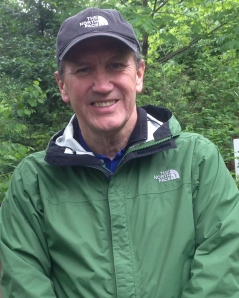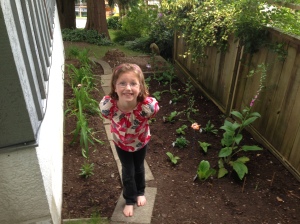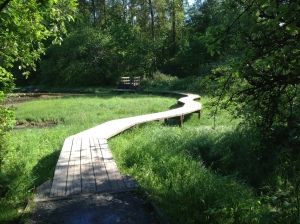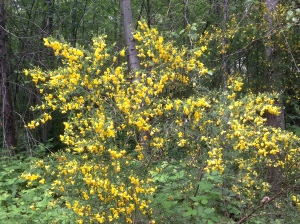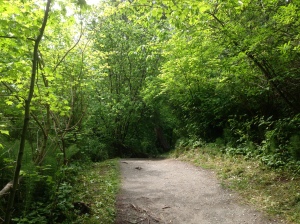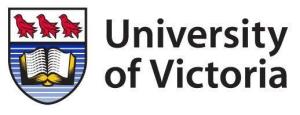I decided to a take a complete break from running for two weeks. It seemed like a prudent thing to do after training hard for 4 months and then running 21K in the BMO Vancouver Half Marathon race!
I really love to run, as you know. So taking a two week break is quite hard for me, especially given that I can run again following my accident in 2010. It took a good year and a half’s rehabilitation before I could run for any length of time again.
When I am not running, my body and mind seem to miss the endorphins. So I have to get back to my running routine by the end of this week, at the latest!
This past week has actually been a tough one for me, and not just because I haven’t been running. Last Sunday, I was bending down, got up quickly and hit my head on the corner of a piece of wood shelving in the house. It was a freak accident, it happened in a flash and it really hurt!
The top of my head was cut and there was quite a bit of blood. Although I knew that it was nothing like as bad as my accident and brain injury back in 2010, it was bad enough. I was dizzy, in pain and my headache and tinnitus greatly increased. I was also experiencing that same ‘mental fogginess’ that I had for a long time following my 2010, and still get with extreme stress and fatigue.
For the next few days, I was concerned that I might be dealing with a serious setback in my recovery. I was also very frustrated and upset with myself for ‘letting this accident happen’, especially considering that I was feeling so good after completing over 4 months of ‘running rehabilitation’.
Fortunately, my increased symptoms and the ‘fogginess’ had subsided by the end of the week, and I am now almost back to where I was before this accident.
Given all the stress around the accident, re-injuring my head and the increased symptoms, I really needed to rest and relax this past weekend.
So I did some gardening on Sunday with my 7 year-old daughter Megan. We created a butterfly garden together by the side of our house. We first cultivated and then we put in lots of wild flowers that we think will attract the butterflies.
Megan is so proud of her butterfly garden. It looks really beautiful and she can hardly wait for the butterflies to arrive.
I have come to love gardening over the past 2 years. There were times when gardening was the only exercise I could do without bringing on my symptoms.
I have found gardening to be extremely therapeutic and fulfilling.
Gardening also offered me quiet times and the solitude I needed at the time to reflect on what had happened to me and contemplate my future.
Another activity that I often recommend for chronic pain self-management and rehabilitation is to volunteer your time and help others in your community.
I am currently a volunteer Program Leader with the University of Victoria’s Centre on Aging, based in Ladner, BC, where I facilitate our Chronic Pain Self-Management workshops.
It’s continues to be an incredible experience for me. I feel honoured and blessed to have this unique opportunity to serve others in need within my community.
As a workshop facilitator, one of the first and most interesting discussions that I have with our participants is when we ask ourselves ‘what is chronic pain?’.
Most of us agree from our personal experiences that it’s a pain that lasts for more than 3-6 months, it typically varies in intensity from mild to excruciating, and it can affect one or multiple areas of the body.
Also, we realize that chronic pain has no survival value. In other words, the pain no longer warns us of any immediate danger. Although the mechanisms of chronic pain are not well understood, we know that it’s typically a long-term situation with no cure.
For most of us, it seems that our chronic pain seems to somehow be inter-twined with chronic stress. Additionally, we agree that physical activity, balanced with rest, is key to managing our chronic pain and stress. I have certainly found this to be the case, having utilized running rehabilitation a great deal over the past year.
Another question that we discuss as a group early in our workshops is ‘what does chronic pain mean to me?’
For many of us, our chronic pain means that we are unable to work due to chronic pain, stress and various other symptoms. Given this situation, most are concerned how we will support ourselves, and our families for the future.
Chronic pain for most of us means that there are many physical things that we used to do that we can no longer do. Personally, I can still no longer do any sport or physical activity that involves sudden movement and/or rapid starts and stops that causes my brain to be shaken around, such as playing soccer with my kids or even coaching their soccer teams.
As a group, early in the workshop we all seem to intuitively know that becoming a good self-manager is our ultimate goal and will serve us well.
Once we are good self-managers, our healthcare providers then become our highly valued ‘teachers and advisers’ helping us self-manage our own chronic pain. After all, no one knows our body and chronic pain better than ourselves!
In next week’s blog, I will talk about the ‘chronic pain and symptom cycle’ and also about what we refer to as our chronic pain ‘Self-Management Tool Box’.
In the weekly blogs that follow, I will share more with you about the various tools and techniques within our ‘Self-Management Tool Box’.
As for myself, after a tough few weeks, I am back to feeling optimistic and philosophical. My accident served as a reminder that I must still stay vigilant to avoid further head injuries.
It has become clear to me that my stress and fatigue-related headache and tinnitus symptoms are indeed chronic and may always be with me just beneath the surface, so to speak
It’s time for me to move forward and focus on honing my chronic pain self-management skills rather than looking for a rehabilitation program that will completely ‘cure’ my symptoms.
After all, I now have many tools and techniques that I know work well for me to break the pain and symptom cycle. Tools such as running, healthy eating, meditation, quality sleep, adequate rest, and volunteer work.
It’s time for me to live life in the present moment again, and to be thankful for all of my blessings. I want to enjoy more time with my wife Marjory and our two children. I also want to find additional work where I can serve people in need.
In closing, if you or someone close to you is dealing with chronic pain and you are an adult living in BC, I strongly encourage you to consider taking our chronic pain self-management workshop. Use the link below to find out more information.
Thank you!
_______________________________________________________________________________________________________________
John Murphy is a volunteer Program Leader with the University of Victoria’s Centre on Aging, based in Ladner, BC. He currently facilitates their 6-week Chronic Pain Self-Management workshop, available free of charge across BC, to adults and their partners and caregivers who are dealing with chronic pain.
For more information on the Chronic Pain Self-Management workshop and several other free of charge workshops, go to http://www.selfmanagementbc.ca
